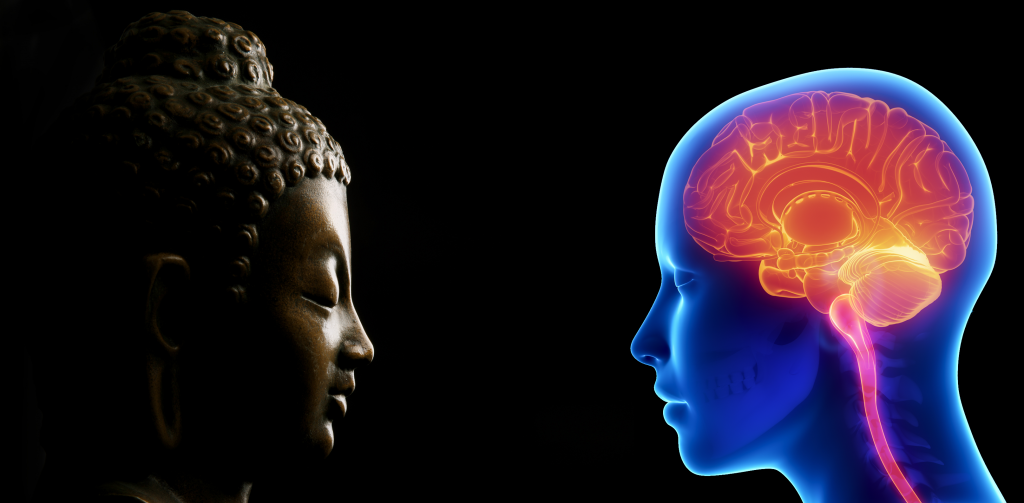30 Jun Your Brain On Yoga
“The science is pointing to yoga being beneficial for healthy brain function, but we need more rigorous and well-controlled intervention studies to confirm these initial findings,”
– Prof. Jessica Damoiseaux
Over the last few decades, yoga has emerged as one of the most popular complementary health activities practiced around the world. With its roots in Indian philosophy, yoga is an ancient practice that combines physical postures (or asanas), rhythmic breathing practices (pranayama) and meditative exercises. All combined together this offers practitioners a unique mind-body experience.
However yoga can sometimes be misconstrued as just another fad form of exercise, a misconception not readily helped by the large number of people on various social media platforms that delight in showing images of themselves in contorted pretzel like positions. Many people see the stretching and miss everything else.

Beyond stretching, yoga has a whole range of positive impacts on our health from reducing stress levels, helping improve cardiovascular health, strengthening the body, and improving breathing function, to relieving symptoms of depression, boosting metabolism, and just making you feel gosh darn better. Really the list could just go on and on.
As yoga becomes more mainstream there has been an increase in the amount of research conducted into the claims of the effects of yoga onto our bodies. But it really has been just the last few years that more studies have been undertaken into the effect of yoga on the brain, in particular the breathing and meditative side of the practice.
So what exactly is our brain?
The brain is one of the largest and most complex organs within our bodies, made up of more than 100 billion nerves, that communicate via trillions of connections, or synapses.
Our brain is made up of two types of tissues; white matter and grey matter. Both of these tissues have an important role to play in healthy cognitive functioning. They have their own independent functions but work together to help you coordinate your movements, to think, and to interpret the world around you. Any damage, or reduction, in just one or another area of your brain will negatively affect these cognitive abilities.
But for those of us who aren’t brain surgeons, what does this really mean? Well, ultimately grey matter is linked to your general intelligence, and white matter allows connection and communication between the regions of the brain. So the thicker the grey matter you have in one area of your brain, the more cells are present there, the better you will be able to perform in that aspect.
For example, London Black Taxi drivers are well known for having extensive knowledge of London roads and being able to navigate around the city and the traffic within. Studies have shown that these individuals have a higher volume of grey matter in their hippocampus, which is an area of the brain linked to memory and spatial navigation.
How does yoga play a role?
In a review by Gothe et al. of 11 different research studies, it was found that participants who either had a regular yoga and meditation practice or started undertaking a weekly practice over a period of anything from 10 to 24 weeks, showed an increase in the amount of grey matter in areas of their brains, particularly around the hippocampus, when compared to those who did not have any form of practice.
This increase in the size of the hippocampus is something that research has previously also found associated with other forms of aerobic exercise, and is especially important as this is an area of our brain that shrinks as we age. It is also the first area that is affected by diseases such as dementia and Alzheimer’s, so maintaining its health is important.
Studies have also shown a change in the grey matter in the amygdala, the region of the brain which is associated with emotion and behaviour. Taking in information from your senses and internal organs, you could almost refer to it as the message processing centre of the brain. Unfortunately one of our most prominent emotions is fear, and it is the perception of a threat that causes the amygdala to trigger hypothalamus and our ‘fight or flight’ response.
It is thought that yoga can help decreasing the amount of grey matter in the amygdala, which means there is less activity in this region of the brain. It is this reaction that is believed to make practitioners better able to handle their emotions, such as fear, and also make them better able to relax.
And this is just scratching the surface!
The great thing about all of this information is that many studies have found that we don’t need to have a long term practice to be able to start benefiting from these positive changes to our brains. Dr. Sara Lazar, of the Psychiatric Neuroimaging Research Program at Massachusetts General Hospital, U.S.A. found in her 2005 study that it is possible to increase the grey matter in some regions of the brain with just 8 weeks of Mindfulness-Based Stress Education (MBSR), which is a formal program involving both meditation and yoga practice. This is supported by a study conducted in 2010 which found that participants who meditated for at least 30 minutes a day for 8 weeks displayed an increase in the grey matter in the hippocampus, and a decrease in the grey matter of the amygdala.
Our brain also has an amazing ability to grow and change, due to something called Plasticity. A study conducted by researchers at UCLA found that participants who had a long-term meditation practice (in this study it was considered as 20 years or more) actually produced visible structural changes in the brain, increasing the amount of folds in the brain.
The folds of the brain is the way our body has developed to allow for a large number of cells to be contained in the small space that is our skull. The twisting and coiling of our brain tissues show up in MRI imaging as folds, and is called gyrification, and it is this that allows a large surface area which can hold a large number of neurons. The wonderful thing about the UCLA study is that they found a direct correlation between the number of years of regular meditation practice and the gyrification in the participants brain’s. More meditation means more gyrification, which means more brain cells, and this allows for better functioning and faster information processing.
Finding information about how yoga affects our brain can open up a rabbit hole of interesting articles, but one thing they all agree on is that all aspects of our asanas, pranayama and meditation, combined together produce a wonderful holistic benefit to our bodies, both inside and out.
Sources;
“Yoga Effects on Brain Health: A Systematic Review of the Current Literature”. Neha Gothe et al.




Sam
Posted at 23:39h, 01 JulyI notice the difference since lockdown. Missing an actual class and lack of motivation at home has definitely caused my internal chatter to rise.
Victoria Liles
Posted at 11:45h, 02 JulyI completely understand! I have had a couple of moments of lethargy and no motivation. I really got back into doing just a short morning meditative moment and found that this has helped me immensely. It has been discussed that your brain noticeable changes with just 100 minutes of meditation.